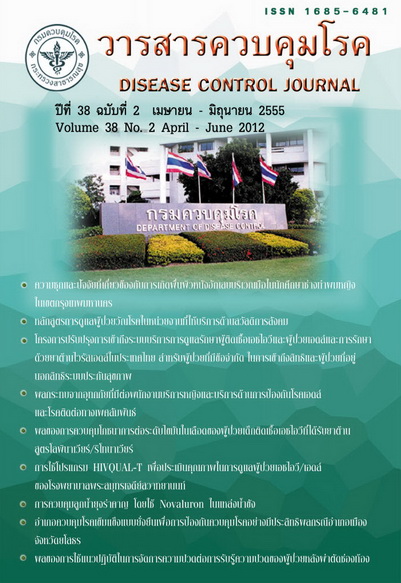Prevalence and Associated Factors of Hand Contact Dermatitis in Female Hairdresser Students in Bangkok
Keywords:
Prevalence, Contact dermatitis, Hairdresser studentAbstract
Hairdresser trainees study process included shampooing, coloring, curling, bleaching, and straightening. They were exposed to many chemicals causing of multiple diseases, especially contact dermatitis. The aim of this study were to determine the prevalence and associated factors of hand contact dermatitis. A cross-sectional descriptive study was conducted during March to April, 2011. Sample was 250 female hairdresser trainees in 12 government hairdressing training centers in Bangkok who studied hairdressing program for 2 months, aged >15 years. Data was collected by questionnaire, and physical examination. Participation rate was 100%. The results showed that the prevalence of hand dermatitis was 22.4%. Factors which were statistical significantly associated with hand dermatitis were age, history of atopy, family history of atopy, rubber and food allergic history, length of hair curling study > 20 hours, and soap exposure. However, underlying disease, metal allergic history, glove type, glove used, duration of glove used and hand washing frequency were not showed relation with hand dermatitis. In conclusion, this study showed that hair curling was high risk of contact dermatitis. Hairdresser trainees should always use glove, should not use rubber glove in hair curling process, and should wash hand with soap after chemical expose. Academies should educate in contact dermatitis, working process, basic treatment, and prevention to hairdresser trainees. Moreover, surveillance of hand contact dermatitis in hairdresser trainees who were aged, history of atopy, asthma, family history of atopy, rubber and food allergic history because this group was high risk of hand contact dermatitis.
Downloads
References
2. สถาบันโรคผิวหนัง กรมการแพทย์ กระทรวงสาธารณสุข ประเทศไทย. สถิติโรคผิวหนังจากการทำงานปี พ.ศ. 2550. 2008
3. สุวิรากร โอภาสวงศ์. โรคผิวหนังเหตุอาชีพ. In: สมชัย บวรกิตติ โยธิน เบญจวัง ปฐม, สวรรค์ปัญญาเลิศ editors. ตำราอาชีวเวชศาสตร์. กรุงเทพมหานคร: เจ เอส เค การพิมพ์; 2542. p. 448-62
4. Mahbub MUC, Howard IM. Occupational Skin disorder. In: LaDou J, editor. Current occupational and environmental medicine. 4th ed: McGraw-Hill Companies, Inc; 2007. p.296¬7
5. Lind ML, Albin M, Brisman J, Diab KK, Lillienberg L, Mikoczy z, et al. Incidence of hand eczema in female Swedish hairdressers. Occupational and environmental medicine 2007; 64(3): 191-5
6. Leino T, Tammilehto L, Hyt?nen M, Sala E, Paakkulainen H, Kanerva L. Occupational skin and respiratory diseases among hairdressers. Scandinavian journal of work, environment & health 1998; 24(5): 398-406
7. Uter W, Gefeller O, Schwanitz H. Occupational dermatitis in hairdressing apprentices. Early- onset irritant skin damage. Current problems in dermatology 1995; 23: 49-55
8. Occupational dermatitis. In: Rietschel RL, Fowler JF, Fisher AA, editors. Fisher's Contact Dermatitis. 5th ed: Lippincott Williams & Wilkins; 2001. p. 441-2
9. Black MM, Russell BF. Shampoo dermatitis in apprentice hairdressers. Occupational Medicine 1973; 23(4): 120-4
10. Aguire A, Zabala R, Galdeano cs, Landa N, D?az-P?rez JL. Positive patch tests to hydrogen peroxide in 2 cases. Contact Dermatitis 1994; 30(2): 113
11. Warshawshki L, Mitchell J, Storrs FJ. Allergic contact dermatitis from glyceryl monothioglycolate in hairdressers. Contact Dermatitis 1981; 7(6): 351-2
12. Storrs FJ. Permanent wave contact dermatitis: contact allergy to glyceryl monothioglycolate. Journal of the American Academy of Dermatology 1984; 11(1): 74-85
13. Moursiden H, Faber o. Penetration of protective gloves by allergens and irritants. Transactions of the St John's Hospital Dermatological Society 1973; 59(2): 230-4
14. Susitaival P, Flyvholm MA, Meding B, Kanerva L, Lindberg M, Svensson, et al. Nordic Occupational Skin Questionnaire (NOSQ-2002): a new tool for surveying occupational skin diseases and exposure. Contact Dermatitis2003; 49(2): 70-6
15. Crawford GH, Katz KA, Ellis E, James WD. Use of aromatherapy products and increased risk of hand dermatitis in massage therapists. Archives of Dermatology. 2004; 140(8): 991-6
16. Gok CL. Irritant contact dermatitis. In: English JSC, editor. A Color Handbook of Occupational Dermatology: Manson Publishing Ltd; 1998. p. 21
17. Frosch p. Cutaneous irritation. Textbook on contact dermatitis 1995; 2: 28-61
18. Malten K. Thoughts on irritant contact dermatitis. Contact Dermatitis 1981; 7(5): 238-47
19. Meding B. Epidemiology of hand eczema in an industrial city. Acta dermato-venereologica Supplementuml990; 153: 1-43
20. Warshaw EM, Ahmed RL, Belsito DV, DeLeo VA, Fowler JF, Maibach HI, et al. Contact dermatitis of the hands: cross-sectional analyses of North American Contact Dermatitis Group Data, 1994-2004. Journal of the American Academy of Dermatology 2007; 57(2): 301-14
21. Jungbauer F, Van Der Harst J, Schuttelaar M, Groothoff J, Coenraads p. Characteristics of wet work in the cleaning industry. Contact Dermatitis. 2004; 51(3): 131-4
Downloads
Published
How to Cite
Issue
Section
License
Articles published in the Disease Control Journal are considered as academic work, research or analysis of the personal opinion of the authors, not the opinion of the Thailand Department of Disease Control or editorial team. The authors must be responsible for their articles.






